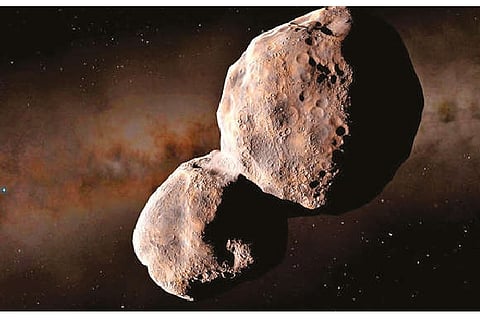

Chennai
Scientists led by Sunao Hasegawa from JAXA, the Japanese space agency, reported in The Astrophysical Journal Letters on Monday that two objects spotted in the asteroid belt between Mars and Jupiter appear to have originated beyond Neptune. The discoveries could one day provide direct evidence of the chaos that existed in the early solar system.
“If true it would be a huge deal,” says Hal Levison, a planetary scientist at the Southwest Research Institute in Colorado, who was not involved in the research. Earth’s stellar neighbourhood is fairly stable today. But 4 billion years ago, chaos reigned as the orbits of Jupiter and other giant planets beyond it may have shifted. The gravitational havoc caused by this planetary dance likely threw pieces of rock and ice all over the place.
“It was very dynamic,” said Karin Öberg, an expert in solar system evolution from Harvard University who was not involved in the new study. Some of those rocks settled into the gap between Mars and Jupiter and became the asteroid belt. Most of the material is believed to be fairly similar hunks of inactive rock that failed to form planets.
But then there are two objects called 203 Pompeja and 269 Justitia.
They orbit at about 2.7 and 2.6 times the Earth-sun distance, well within the asteroid belt. 203 Pompeja, at about 70 miles across, appears to be structurally intact, whereas 269 Justitia, only 35 miles or so, is likely a fragment of a previous collision. Both have stable circular orbits, meaning they must have settled into this space long ago.
Both also have an unusual color. Objects in the inner solar system tend to reflect more blue light because they are devoid of organic material — things like carbon and methane — whereas objects in the outer solar system are redder because they have a lot of organics, perhaps the building blocks of life on Earth.
“In order to have these organics, you need to initially have a lot of ice at the surface,” said Michaël Marsset from the Massachusetts Institute of Technology, a co-author on the paper. “So they must have formed in a very cold environment. Then the solar irradiation of the ice creates those complex organics.”
These two rocks, as it turns out, are extremely red — more red than anything else seen in the asteroid belt. While tentative hints of other red asteroids have been found, these two appear to be special.
The finding, if correct, would offer evidence for planetary migration in the early solar system, particularly in support of an idea called the Nice Model, with Saturn, Uranus and Neptune all moving outward, and Jupiter inward slightly, over a few hundred million years. This would have perturbed organic-laden asteroids leftover from the formation of the planets, sending them pinging around the solar system.
“It’s an exciting discovery with implications for the origins of life,” Dr. Öberg said. Most of these leftover objects in the present day are known as trans-Neptunian objects and orbit in the Kuiper belt beyond Neptune. Many are red in color, like Arrokoth, the rock that NASA’s New Horizons mission got a close-up of in 2019. 203 Pompeja and 269 Justitia both appear to match them.
The writer is a journalist with NYT
The New York Times
Visit news.dtnext.in to explore our interactive epaper!
Download the DT Next app for more exciting features!
Click here for iOS
Click here for Android